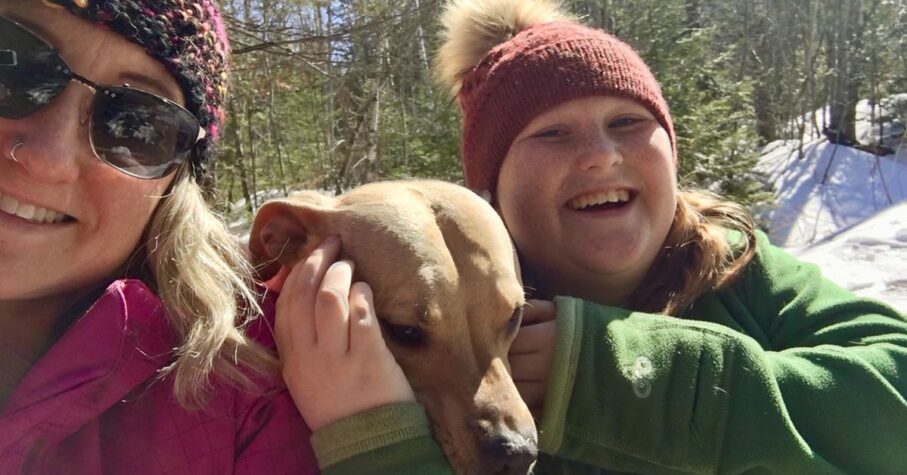
Alison Murphy | Photo from source article
By Greg Mercer | The Globe And Mail
Stella, an eight-year-old pit bull-labrador mix, doesn’t know anything about self-isolation, quarantine or the COVID-19 pandemic that has dramatically altered life around the world. All she knows is that she’s suddenly getting to go for long romps through the woods outside the village of Gagetown, N.B., every afternoon with her family, instead of waiting alone all day for a short walk around the block. “She’s loving it, and it’s become the best part of our day. It’s keeping us sane,” said the dog’s owner, Alison Murphy, a mother of two. “Normally, Stella is home alone from about 8 a.m. to 4:30 p.m. Now she’s with us all the time.”
With thousands of Canadians spending a lot more time at home with their pets, the animals we share our lives with may be enjoying social distancing more than anyone. In many cases, those pets are also helping their owners deal with these anxious times, too.
Ms. Murphy, who runs a non-profit arts organization, has been relying on Stella to help cope with the stress of the pandemic. Life has become a lot more distressing lately – she’s in self-isolation after taking a flight from London on a plane with a COVID-19-infected passenger, while trying to home-school her two daughters and run her organization full-time from the house. While she’s since tested negative for the coronavirus, it’s been an unsettling time, and she’s grateful for her dog’s companionship. “Being in the woods with the dog, it’s the only time that my brain shuts off from the worry,” Ms. Murphy said.
Many Canadians, such as Oakville’s Rachel Schoutsen, are adapting to the new reality of working from home with pets. Her employer told most staff to start working remotely last week, which means her toy poodle Sunny is suddenly getting a lot of extra attention. “I don’t know how we’re going to retrain her when this is all over,” said Ms. Schoutsen, a host at the Weather Network. “She’s basically been waiting for self-isolation because she knows how to pee on the balcony. If it gets to the point where we couldn’t leave the condo, it wouldn’t be a problem for her…. For now, I still walk her outside, but I wear gloves, and we don’t really talk to anybody.”
While the COVID-19 outbreak has meant changes in pet-care routines, it also comes with some unique challenges for pet owners, and for people who spend a lot of time around those animals. While there’s little evidence to suggest pets themselves can become sick, there is concern they could potentially carry the virus and spread it to other people. “We have to think about animals as an extension of the family. If we’re worried about getting the virus on our kids, our spouses or loved ones, then we need to be a little bit cautious as well about making sure we’re not getting the virus on our pets,” said Dr. Jason Stull, a veterinary epidemiologist at the Atlantic Veterinary College in Charlottetown.
That means social distancing rules apply for pets, too – public areas such as dog parks should be avoided, and we should try to not touch animals that aren’t ours, he said. If you or someone in your home has the virus, you should also reduce contact with your pets as much as possible. “If you’re sick with COVID-19, you shouldn’t be sneezing on your pet, you shouldn’t be coughing on your pet, your pet shouldn’t be laying in your lap,” Dr. Stull said. If you’re healthy and not experiencing symptoms, there’s no need to stop cuddling your favourite animal. Pets can have a very therapeutic effect in these anxious times, Dr. Stull said. The important thing is to be a responsible owner, avoid social gatherings with your pets and try to slow the spread of the disease.
Other people who normally work with pets are suddenly distancing themselves from animals, out of fears of infection. Many groomers are declining appointments, which means Sunny will be one shaggy pup by the time she gets her next haircut, Ms. Schoutsen said. The Canadian Association of Professional Dog Trainers, meanwhile, recommends that anyone training a puppy at this time should not keep them at home to avoid exposure, but should maintain safe social distances when taking young dogs outside.
Some of the fears around pets have been fuelled by the case of a Pomeranian in Hong Kong, which died after traces of COVID-19 were found in its mouth. But virologists argue it was likely the age of the pet and other underlying illness, and not the virus, that caused its death. For people who work in veterinary hospitals, there are some very real concerns around limiting exposure to the virus, Dr. Stull said. Groups such as the SPCA say they are only accepting urgent calls right now, while many vets are reducing contact with the public. “We’re doing all we can to understand the role that animals play in all this,” Dr. Stull said. “It only takes a couple of people who think this doesn’t apply to them for big problems to occur. It’s really important we all take this seriously.”
For people who love pets, it’s all a little bit hard to get used to, Ms. Schoutsen said. “This morning I was walking Sunny, and a woman bent down and started petting her. She immediately stopped and said ‘I’m so sorry, I shouldn’t be touching your dog,’” she said. “It’s so weird. I’m worried my dog could be a catalyst for passing this virus around.”
By Greg Mercer | The Globe And Mail | Published On March 24, 2020
The information contained is as of date of publication and may be subject to change. These articles are intended as general information only.







